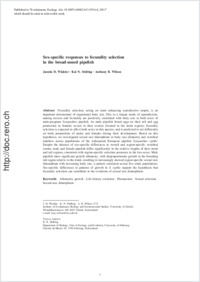Sex-specific responses to fecundity selection in the broad-nosed pipefish
- Winkler, Jasmin D. Institute of Evolutionary Biology and Environmental Studies, University of Zürich, Switzerland
- Stölting, Kai N. Institute of Evolutionary Biology and Environmental Studies, University of Zürich, Switzerland - Department of Biology, Unit of Ecology and Evolution, University of Fribourg, Switzerland
- Wilson, Anthony B. Institute of Evolutionary Biology and Environmental Studies, University of Zürich, Switzerland
-
06.09.2011
Published in:
- Evolutionary Ecology. - 2012, vol. 26, no. 3, p. 701-714
English
Fecundity selection, acting on traits enhancing reproductive output, is an important determinant of organismal body size. Due to a unique mode of reproduction, mating success and fecundity are positively correlated with body size in both sexes of male-pregnant Syngnathus pipefish. As male pipefish brood eggs on their tail and egg production in females occurs in their ovaries (located in the trunk region), fecundity selection is expected to affect both sexes in this species, and is predicted to act differently on body proportions of males and females during their development. Based on this hypothesis, we investigated sexual size dimorphism in body size allometry and vertebral numbers across populations of the widespread European pipefish Syngnathus typhle. Despite the absence of sex-specific differences in overall and region-specific vertebral counts, male and female pipefish differ significantly in the relative lengths of their trunk and tail regions, consistent with region-specific selection pressures in the two sexes. Male pipefish show significant growth allometry, with disproportionate growth in the brooding tail region relative to the trunk, resulting in increasingly skewed region-specific sexual size dimorphism with increasing body size, a pattern consistent across five study populations. Sex-specific differences in patterns of growth in S. typhle support the hypothesis that fecundity selection can contribute to the evolution of sexual size dimorphism.
- Faculty
- Faculté des sciences et de médecine
- Department
- Département de Biologie
- Language
-
- English
- Classification
- Biological sciences
- License
- License undefined
- Identifiers
-
- RERO DOC 28650
- DOI 10.1007/s10682-011-9516-4
- Persistent URL
- https://folia.unifr.ch/unifr/documents/302365
Statistics
Document views: 83
File downloads:
- sto_ssr.pdf: 119
